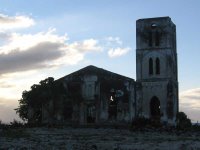
Savaii, much more so than 'Upolu, bears the scars of nature's power. Volcanic eruptions and cyclone activity have made an indelible mark on the landscape and the people of the island. The village of Falealupo, on the western most tip of Savaii, bears that mark more than most.
 Today, the village of Falealupo is a mere shadow of its former self. From the second to the fifth of February in 1990, cyclone Ofa battered the north-western part of Savaii, wreaking considerable destruction. Strong winds, heavy rain and rough seas led to the complete destruction of Falealupo. The village was abandoned. Resources were recycled as best as possible but the villagers chose to leave some ruined buildings stand as they were, as testimony to both the power of cyclone Ofa and the village of Falealupo itself. The most striking of these is the Catholic church that stands close to the water's edge.
Today, the village of Falealupo is a mere shadow of its former self. From the second to the fifth of February in 1990, cyclone Ofa battered the north-western part of Savaii, wreaking considerable destruction. Strong winds, heavy rain and rough seas led to the complete destruction of Falealupo. The village was abandoned. Resources were recycled as best as possible but the villagers chose to leave some ruined buildings stand as they were, as testimony to both the power of cyclone Ofa and the village of Falealupo itself. The most striking of these is the Catholic church that stands close to the water's edge.With its roof long gone and walls crumbling away the church is slowly giving way to nature. Trees, vines and low shrub are reclaiming the structure, as they have much of the surrounding landscape. The concrete walls are stained with mould and streaked with cracks. The few remaining bas relief sculptures along the walls are losing their features.
 The remains of Falealupo were not the main reason we headed there this weekend. The International Date Line passes within about 60 kilometres of Samoa, making Falealupo the last place on earth. It also means it is possible to watch the sun set over today and tomorrow simultaneously.
The remains of Falealupo were not the main reason we headed there this weekend. The International Date Line passes within about 60 kilometres of Samoa, making Falealupo the last place on earth. It also means it is possible to watch the sun set over today and tomorrow simultaneously.We took some photos of each of us standing at the "edge of the world" (as you do) and watched the sun set. It was quite beautiful. All the while I couldn't help but laugh and think of Monty Python's Crimson Permanent Assurance and how "they sailed off into the ledgers of history...or so it would have been, if certain modern theories concerning the shape of the world had not proved to be...disastrously wrong." Unlike the Crimson Permanent Asssurance, we didn't see the edge of the world, but we did see today and tomorrow all at once, which I'm more than happy about.
We spent our evening in beach fales about a kilometre down the road from the ruined church. Whilst there we bumped into a friend of ours, Maka, who is a US Peace Corps volunteer living on Savaii. He was heading home to the nearby village of Papa and invited us to visit him the following day. After breakfast and a quick swim, we packed our bags into the car and drove away from the last place on earth to take him up on his offer.

No comments:
Post a Comment